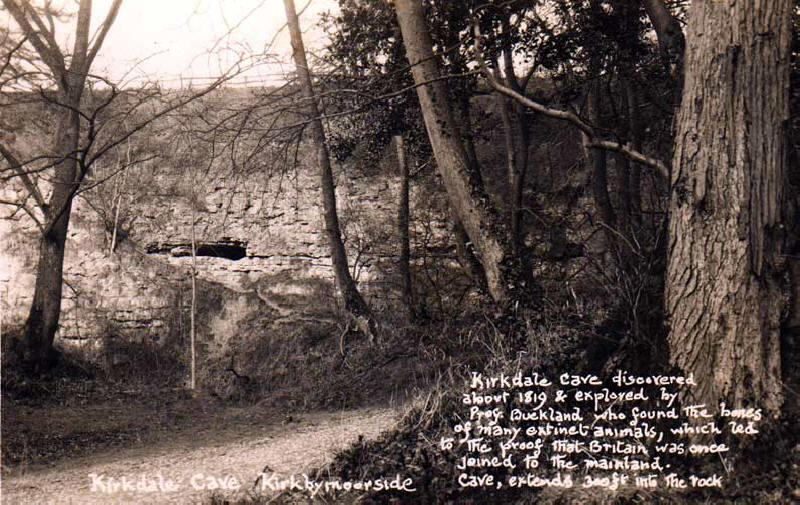2
million BC
The
ground on which the village stands was once a tropical forest. Because
of continental drift the land itself once lied much further south in the
tropics and moved to its present position as a result of crust movement.
Even after this movement climate was very different in glacial and
inter-glacial periods caused by variation in the earth's orbit and activity of
the Sun. Only a few miles away at Kirkdale
is a cave where fossils of hyena, bear, lion, tiger, wolf, fox, weasel,
elephant, rhinoceros, hippopotamus and three types of deer were found.
These date 80,000 to 90,000 years before present day in a warm period between
ice ages. Kirkdale is in fact the most productive fossil cavern in
Britain.
Kirkdale River Ford (water splash)

25,000 BC
A huge ice sheet had covered the North Sea. It
blocked the natural direction of drainage and a lake formed. Lake
Pickering stretched
stretched from
Gilling in the west to
Sherburn in the east sediment built up which we walk on today. At
one point the waters of the lake lapped the entrance to
Kirkdale cave. When the ice started to melt the lake overflowed
creating Kirkham Gorge. Left behind in the
debris was rich boulder clay, later augmented by sand, gravel and silt
deposits, which the farmers of today can thank for the crops they raise.
There
were humans around at this time. They had made their way across the land
bridge from the rest of Europe they made camps on high ground, but led a
nomadic life.
8000
BC
Britain
becomes an island when the last ice age closes and sea levels
rise. Starr Carr ,
a site excavated near Seamer, was probably a
seasonal hunting camp around this time.
4000
BC
There is
some evidence to indicate that some nomads began to farm and build more
permanent settlements. An increase in fossil evidence of dung beetles
indicates higher numbers of cattle. It is believed that the forest cover
started to be cut to form clearings. The present appearance of the North
York moors relates to human activity removing woodland.
3000
BC
Stonehenge is built. Similar structures were symbols of ownership, beacons in
the landscape saying ‘this land is taken’.
2000
BC
Bronze
Age Celts occupied the area.
Their religious leaders were druids. Their print can still be found in some of
the names in the district. The name of the River Dove is of Celtic
origin. Normanby lay in the area controlled by the
Brigantes, a confederation of tribes who occupied
the area between the Humber and the Scottish border. To the East the
land was occupied by the Parisi who constructed
distinctive square barrows, occasionally containing
chariots of the aristocracy.
43 AD
The
Romans led by Emperor Claudius came to Britain. They built monumental
civil engineering works like Hadrian’s Wall. From the fort at
Malton, an early military base, a road was
constructed to Cawthorne camps in the north where
the soldiers practised military techniques. This road passed by
Normanby.
|
|

|
|
The ‘Hollows Medallion’.
|
|
|
|
Malton was
occupied by the Romans until the fifth century, even after the abandonment of
Scotland. Some
kings and chiefs resisted the Romans. Boudicca,
the famous Saxon Queen, fought battles close by. When one of her
followers dropped a medallion in the grass little did he know that it would
remain untouched and well preserved for almost 2000 years when in 1975 Vince
Hollows, a local farmer saw it glinting in one of the fields of
Riseborough Hagg farm.
It is a medallion for a person or possibly a horse, dated in the first century
AD. The British Museum has compared it to similar finds known as the
Stanwick hoard of
Boroughbridge near where Boudicca has been
chronicled as fighting battles with the Roman invaders. It is in
amazingly good condition, and was exhibited in the year 2000 exhibition. From 208
to 211 the emperor of the Roman Empire, Septimus
Severus, lived close by at York from where he
ruled his vast domain.
300 AD
In the
third century Christianity reached Britain. Oxen started to be used for
ploughing and this was the case case for 300 years. In 367 Roman Britain was assailed on all sides.
Picts invaded from the North, Irish from the West
and Saxons landed on the North Sea coast. Within 40 years Britain was no
longer under Roman control.
500 AD
The
Angles and Saxons, which originated around the River Elbe in Germany and later
spread to the coast between Jutland and the Rhine Delta, settled in the area. Yorkshire
became part of the kingdom of
Deira
which was within the Danelaw granted in 878 by
King Alfred who had control of the rest of the country. The Celts
retreated west and kept their religion but the rest of the land was heathen.
900 AD
|
|

|
|
ULF'S Horn-on display in York Minster Treasury
|
|
|
|
Yorkshire began to be
over-run by the Vikings. York was captured in 866. Danish place names appeared ending in
'by'.
Ulf was a
sub-king of Deira. He was the brother-in-law
of King Canute owning vast tracts of land,
including some around Edstone. When he
became Christian he gave large portions of land to St. Peters church at York
where York Minster now stands. At the
time, the custom when conveying land title was to give over a drinking horn.
Ulf's horn is one of the treasures of York Minster. It was made at
Salerno in Italy from elephant tusk and has carvings of mystical animals which
look like griffins. Silver fittings were added in the 17th century by Thomas
Mangy of York.
Top